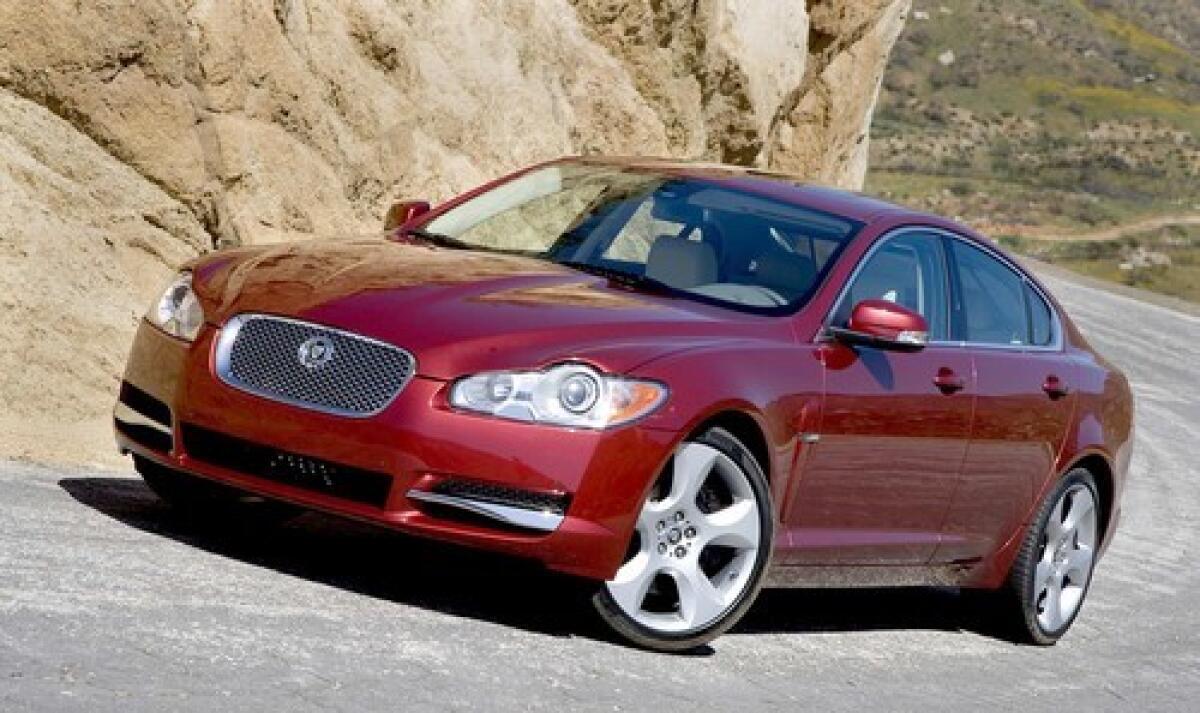2009 Jaguar XF

Jaguar’s reputation for luck -- which is not to have any -- continues with the 2009 Jaguar XF, the company’s new and utterly pivotal midsize, V8-powered sedan. In the best of times, launching a luxury sedan against the likes of established winners such as the BMW 5-series and Audi A6 would be a scary proposition, and these aren’t the best of times. The XF lands just as the U.S. economy is in a flat spin, premium gas is hitting $4 per gallon and the luxury car market is falling on its posh butt.
Meanwhile, the very same month as the XF launch (March), Jaguar and Land Rover were all but acquired from Ford by India’s Tata Group, an event that, with its Empire-strikes-back overtones, has backlit the brand with an aura of decline.
The good news is that Tata Group, which will pay $2.3 billion for Jag and Land Rover when the deal is approved later this year, will invest heavily in the storied old marquees. Just last week, Tata hinted that Jag would field a sports car to take on Aston Martin. That can only mean a modern-day E-type, a car devoutly wished for by Jag enthusiasts. Meanwhile, Tata has committed to keeping production in England, to treading lightly on the company’s current management, and generally to honoring the Britishness of this quintessentially British brand. More good news: Jag’s quality is vastly improved and their customer service was tops in J.D. Power’s 2007 survey.
The bad news is that Jaguar, which has wandered the wilderness so long, will wander a while longer. Which brings us to the XF.
The XF is a very fine motorcar in a market segment that demands utter perfection; it’s a reasonably attractive sedan from a company that needs a ravishing, wallet-emptying beauty. On this second point, I don’t think there’s much disagreement. You can couch adequacy all you want: You can call the XF “handsome,” say it’s purposeful rather than pretty, admire its well-planted stance. The glass-to-sheet metal proportions, the sinuous profile, the glossy encapsulation of the body all work. The roof pillars are slim, almost delicate.
But the front of the car -- where the poetry of a brand resides -- is kind of a mess. The molded mesh-like grille just seems to float there, unconnected to the fluting on the hood (which ideally would suggest contrails streaming back from the grille perimeter). Jag’s chief designer, Ian Callum, argues that he wanted to make a clean break with the previous model, to take brand design in a new direction. I suppose. But, just as an experiment, readers should pick up a Sharpie marker and draw Jag’s traditional upright-oblong grille -- like the one from the outgoing S-Type, and the original R-D6 concept -- onto the picture on this page.
There’s a technical problem in the XF too, and that’s the large gap in the hood over-slam, especially around the headlights. Apparently the problem arose because of an outdated French motor vehicle requirement that owners be able to change the bulbs in the headlamps. In any event, it makes the car look as if the hood isn’t closed.
If that seems like a lot of bother over the grille, well, Jaguar isn’t Subaru. The Jaguar brand is an ongoing narrative of motoring enchantment, whose solemn code is “beautiful, fast cars.” In a world full of BMWs, Mercedes and Audis (and Infiniti, which makes perhaps the best car in this class), Jag has no place unless it is -- as the ad campaign says -- gorgeous.
The XF comes in three flavors: “Luxury” ($49,200) or “Premium Luxury” ($55,200), both powered by a naturally aspirated version of the company’s 4.2-liter, 300-hp V8; or the “Supercharged” ($62,200), which is comprehensively equipped and, with 420 horses in harness, seriously quick (0-60 in 5.1 seconds). The Supercharged version comes with 20-inch wheels standard. In order to preserve the close-fit look between the wheels and the fender wells in the naturally aspirated models, Jag stylists dictated the 18- and 19-inch wheel-and-tire sets (standard and optional) should have the same rolling diameter of the 20-inchers. The net is that all three cars have the deep-set, ready stance that big wheels provide.
Mechanically, the XF is a sedan version of the XK coupe/convertible. The chassis is the same (wishbone front suspension and multi-link in the rear, with adaptive suspension on the Supercharged edition); the engines and transmission (six-speed automatic with manual shifting) are shared, as are braking, steering and major subsystems.
Like the coupe, the sedan is lushly quiet overall, but put the boot to the accelerator and you get an earful of the slightly acrid exhaust note (the product of the car’s tuned exhaust system). Like the coupe, the car feels big and powerful, more linebacker than halfback. And like the coupe, the XF weighs a lot, a hefty 4,194 pounds in Supercharged trim.
That weight requires a more deliberate driving style than, say, a BMW. You can’t just toss the XF into a corner unless you want to wildly chatter the stability control; but, if you bend it into a long sweeper and squeeze the throttle, it turns in confidently and hangs on tenaciously. The S/C model has a Dynamic Mode in its stability control system, allowing drivers to slide the car around a bit more. It’s fun.
The thing the XF Supercharged does best is to turn small holes in traffic into big holes with its thick band of thrust (408 pound-feet at 3,500 rpm). Go ahead, kick that mule. The supercharger whines, the comfy leather seat grips you tighter and the XF surges as if surfing a wave of warm English whiskey.
The commonality between XK and XF programs freed up time and development dollars to focus on the sedan’s interior, which is full of nuance and invention, probably the most striking interior since the redesigned Cadillac CTS.
There’s even a pulse. To add drama to the moment of starting the car, Jag’s stylists gave the “Start” button a rhythmic, heartbeat-like glow. Press the button and the car’s rotary gearshift selector pops out of the central console. Other cars have shift-by-wire (no mechanical linkage to the transmission) but the Jag’s dial-a-gear is unique. I’m not sure how it would be to parallel park with it, but it sure looks cool.
The cabin is full of grace notes. On start-up, the dashboard climate vents rotate into the open position, for instance. The overhead lights and glove box operate by “proximity” sensors rather than buttons or levers. Instead of the usual wood planking, Jag designers went with a broad, textured aluminum fascia across the dash, and wood paneling on the central console. Meanwhile, all the instruments and satiny-silver controls are traced with a blue neon glow, like the keypad of a mobile phone.
The overall effect of the cabin is less British than Scandinavian. The ambience is cool, arty and retro-modern, like Virgil Exner channeled through Ian Schrager. You could argue that a lot of the detailing is gimmicky, that these relatively cheap surprise-and-delight features are there to distract from some major holes in the XF program (no direct-injection, no all-wheel-drive option). I wouldn’t stop you.
So far, XF sales have been good. The company has had more than 4,000 pre-orders -- a major step in the right direction.
Here’s what needs to happen now: Jag has to have a V6 or diesel option at this price point, and soon. The fuel economy of these thirsty V8s is going to be a millstone around the car’s neck. The company needs to emphasize the XF’s equipment level, which is really quite generous for the price. And they need to get working on a nose job.
Jag’s got a pulse but the patient isn’t out of the woods yet.
2009 Jaguar XF Base price: $49,200Price, as tested: $62,200Powertrain: Naturally aspirated or supercharged 4.2-liter, dual-overhead cam V8 with variable valve timing; six-speed automatic with manual shifting; rear-wheel drive.Horsepower: 300 at 6,000 rpm (n.a.); 420 at 6,250 (s.c.)Torque: 310 pound-feet at 4,100 rpm (n.a.); 408 pound-feet at 3,500 (s.c.)Weight: 4,017 (n.a.); 4,194 (s.c.)0-60 mph: 6.2 seconds (n.a.); 5.1 seconds (s.c.)Wheelbase: 114.5 inchesOverall length: 195.3 inchesEPA fuel economy: 16 mpg city, 25 mpg highway (n.a.); 15 mpg city, 23 mpg highway (s.c.)Final thoughts: 98% right
More to Read
Sign up for Essential California
The most important California stories and recommendations in your inbox every morning.
You may occasionally receive promotional content from the Los Angeles Times.








